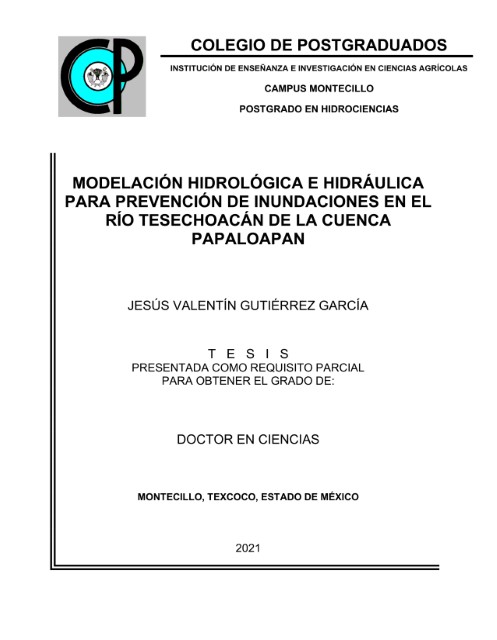
MODELACIÓN HIDROLÓGICA E HIDRÁULICA PARA PREVENCIÓN DE INUNDACIONES EN EL RÍO TESECHOACÁN DE LA CUENCA PAPALOAPAN.
JESÚS VALENTÍN GUTIÉRREZ GARCÍA, Dr. Colegio de Postgraduados, 2021
RESUMEN
En la modelación de cuencas, para el análisis hidrológico e hidráulico, se
requiere estimar los hietogramas e hidrogramas de los caudales. En el presente
trabajo se elaboraron curvas de Intensidad-Duración-Frecuencia (IDF) para
periodos de retorno de 2, 5, 10, 25, 50, 100 y 500 años con datos de
precipitación máxima de 1970-2010 en la cuenca Tesechoacán. Se probó el ajuste
de las distribuciones Gumbel, Normal, Log Normal, Pearson III, resultando con
mejor ajuste la Gumbel doble, con un indicador de Nash-Sutcliffe de 0.98, 0.98,
0.96 para las estaciones de Azueta, Garro y Playa Vicente, respectivamente.
Mientras que para la estación Juan Rodríguez tuvo mejor ajuste la Log Normal
doble de dos parámetros con un índice de Nash de 0.98. Se estimaron las
precipitaciones máximas diarias anuales, así como la intensidad equivalente de
los distintos periodos de retorno, esto mediante el análisis estadístico con
regresión potencial para obtener valores de la ecuación de intensidad,
obteniéndose un R2= 0.93. Se generaron los hietogramas de diseño con apoyo de
las curvas IDF mediante el método de bloques alternos, para su ingreso en la
modelación con HEC-HMS. Los hidrogramas generados se compararon con los datos
hidrométricos de la estación 28013 (Azueta), obteniéndose con el estadístico de
Nash un ajuste de 0.78. Realizado un análisis de sensibilidad al parámetro de
curva numérica (CN) se obtuvo un mejor ajuste de 0.93.
Con los hidrogramas obtenidos en HEC-HMS fueron utilizados en la
modelación hidráulica en Iber para determinar las zonas vulnerables a
inundaciones teniendo como resultados una variación de profundidad de 0.01m a
10.84m. Se elaboraron mapas de riesgo para cada periodo de retorno con una
afectación de 41 localidades y una superficie máxima 34,233.19 ha inundadas
donde el 57.5% pertenece a zonas catalogadas con peligrosidad alta. En la
calibración del modelo hidráulico se realizó con los datos correspondientes al
evento del huracán Matthew, del periodo del 26 de septiembre al 01 de octubre
del 2010, logrando tener ajustes aceptables al comparar los datos simulados con
los datos observados en las 3 estaciones hidrométricas presentes en la cuenca,
con un coeficiente de NASH de 0.78 a 0.98, un coeficiente de determinación de
0.88 a 0.98 y valor de raíz cuadrada del cuadrado medio del error de 44.95 a
86.03 m3/s. Se proponen como alternativas de solución el desazolve, la
construcción de bordos marginales y bordos perimetrales, así como la
implementación de un plan de manejo de inundaciones con apoyo de los mapas de
riesgo generados para disminuir el impacto de inundaciones en la cuenca
Tesechoacán.
Palabras clave: Inundaciones, HEC-HMS, IDF, Iber, Modelación.
HYDROLOGICAL AND HYDRAULIC MODELING FOR FLOOD PREVENTION IN THE TESECHOACAN RIVER OF THE PAPALOAPAN BASIN
JESÚS VALENTÍN GUTIÉRREZ GARCÍA, Dr. Colegio de Postgraduados, 2021
ABSTRACT
In basin modeling, for hydrological and hydraulic analysis, it is required to estimate the hyetograms and hydrographs of the flows. In the present work, Intensity-DurationFrequency (IDF) curves were elaborated for return periods of 2, 5, 10, 25, 50, 100 and 500 years with maximum precipitation data from 1970-2010 in the Tesechoac? basin. The adjustment of the Gumbel, Normal, Log Normal, Pearson III distributions was tested, resulting in the best adjustment of the double Gumbel, with a Nash-Sutcliffe indicator of 0.98, 0.98, 0.96 for the Azueta, Garro and Playa Vicente stations respectively. While for the Juan Rodr?uez station the double Log Normal of two parameters had a better fit with a Nash index of 0.98. The maximum daily annual rainfall was estimated, as well as the equivalent intensity of the different return periods, this through statistical analysis with potential regression to obtain values of the intensity equation, obtaining an R2 = 0.93. The design hyetograms were generated with the support of the IDF curves by means of the alternate blocks method, for their entry into the modeling with HEC-HMS. The hydrographs generated were compared with the hydrometric data from station 28013 (Azueta), obtaining an adjustment of 0.78 with the Nash statistic. Performing a sensitivity analysis to the numerical curve parameter (CN), a better fit of 0.93 was obtained. With the hydrographs obtained in HEC-HMS, they were used in the hydraulic modeling in Iber to determine the areas vulnerable to flooding, resulting in a depth variation from 0.01m to 10.84m. Risk maps were prepared for each return period, affecting 41 localities and a maximum area of 34,233.19 ha flooded, where 57.5% belong to areas classified as highly dangerous. The calibration of the hydraulic model was carried out with the data corresponding to the Hurricane Matthew event, from the period of September 26 to October 1, 2010, achieving acceptable adjustments when comparing the simulated data with the data observed in the 3 hydrometric stations present. in the basin, with a NASH coefficient of 0.78 to 0.98, a coefficient of determination of 0.88 to 0.98 and a square root value of the mean square of the error of 44.95 to 86.03 m /s. The proposed solution alternatives are the desilting, the construction of marginal and perimeter borders, as well as the implementation of a flood management plan with the support of the risk maps generated to reduce the impact of floods in the Tesechoac? basin.
Keywords: Floods, HEC-HMS, IDF, Iber, Modeling.
Fecha: 2021-05
Estudiante: JESÚS VALENTÍN GUTIÉRREZ GARCÍA
DOCTORADO EN CIENCIAS - HIDROCIENCIAS
Consejo Particular:
Consejero: Dr. J. Enrique Rubiños Panta
Asesor: Dr. Demetrio S. Fernández Reynoso
Asesor: Dr. Carlos Ramírez Ayala
Asesor: Dr. Rodrigo Roblero Hidalgo